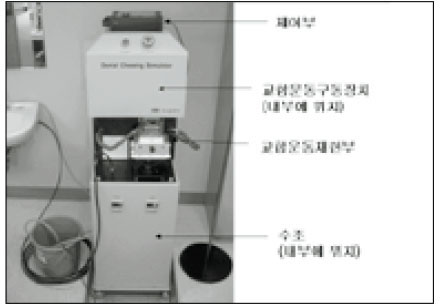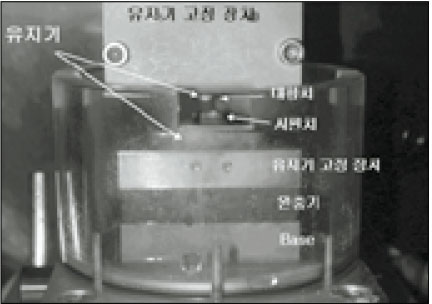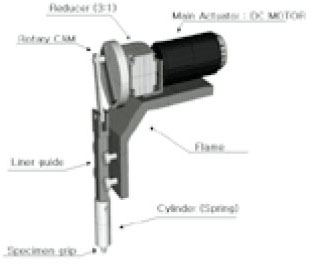J Korean Acad Conserv Dent.
2003 Jan;28(1):34-40. 10.5395/JKACD.2003.28.1.034.
Development of chewing simulator
- Affiliations
-
- 1Department of conservative Dentistry, Yonsei University, Korea. sunghopark@yumc.yonsei.ac.kr
- 2Department of mechanical engineering, Sejong University, Korea.
- KMID: 2117428
- DOI: http://doi.org/10.5395/JKACD.2003.28.1.034
Abstract
- Chewing simulator, which can partly mimic the motion of chewing motion of human, has been successfully developed. The purpose of its development was to make a new machine which can anticipate the clinical results of restoration in the human teeth more accurately in vitro condition It is composed of 4 major parts; chewing part, motor part, water bath, controlling part. The controlling part control the chewing force, frequency, the temperature and running time of water. Additionally, the actual chewing force and remaining time is shown in the monitor of controlling part. At present, the chewing cycle is composed depending on the pre-published data of foreign people. Long term clinical data should be additionally collected for the simulator to mimic the clinical results more accurately.
Keyword
Figure
Cited by 1 articles
-
The effect of intermittent composite curing on marginal adaptation
Yong-Hwan Yun, Sung-Ho Park
J Korean Acad Conserv Dent. 2007;32(3):248-259. doi: 10.5395/JKACD.2007.32.3.248.
Reference
-
1. Powell JM, Phillips RW, Norman RD. In-vitro wear response of composite resin, amalgam, and enamel. J Dent Res. 1975. 54:1183–1195.
Article2. Phillips RW, Avery DR, Mehra R, Swartz ML, Mccune RJ. Observations on a composite resin for class II restorations: Three-yerr report. J Prosthet Dent. 1973. 30:891–897.
Article3. Jaworzyn JF, Arundel PA, Cantwell JB. Posterior composite restorations:simultaneous hydrothermal cycling and wear studies in vitro. J Dent Res. 1978. 57:708.4. Delong R, Peterson R, Douglas WH. A laser profiling system for measuring wear of dental materials. J Dent Res. 1989. 68:907. Abstr 328.5. Krejci I, Reich T, Lutz F, Albertoni M. In vitro-Testverfahren zur Evaluation dentaler Restorationssysteme. Schweiz Monatsschr Zahnmed. 1990. 100:953–960.6. Rateitschak KH, Renggli HH, M hlemann HR. Parodontologie. 1978. Stuttgart: Thieme;8–10.7. Atmaram GH, Mohammed H. Estimation of physiologic stressed with a natural tooth considering fibrous PDL structure. J Dent Res. 1981. 60:873–877.
Article8. Graber G. Gnathologie. Zahntechnik (Zur). 1981. 39:427–446.9. DeLong R, Douglas WH. Development of an artificial oral environment for testing of dental restoratives: Biaxial force and movement control. J Dent Res. 1983. 62:32–36.
Article10. Anderson PJ. Measurement of stress in mastication I. J Dent Res. 1956. 35:664–670.
Article11. Bates JF, Stafford GD, Harrison A. Masticatory function--A review of the literature II. Speed of movement of the mandibule, rate of chewing and forces developed in chewing. J Oral Rehabil. 1975. 2:349–361.12. Jemt T, Karlsson S, Hedegard B. Mandibular movement of young adults recorded by intraorally placed light emitting diodes. J Prosthet Dent. 1979. 42:669–673.
Article13. Uhlig H. Uber die Kaukraft. Dtsch Zahnarztl Z. 1953. 8:30–45.14. Schreiber S. Ein neues Gerät zur Messung und Registrierung von Kaukräfteen. Zahnarztl Rundsch. 1957. 66:127–131.15. Kraft E. Uber die Bedeuting der Kaukraft für das Kaugeschehen. Zahnarztl Prax. 1962. 13:129–130.16. Eichner K. Messung der Krafte bei Kauvorgängen. Dtsch Zahnarztl Z. 1963. 18:915–924.17. Graf H, Grassl H, Aeberhard H-J. A method for measurement of occlusal forces in three directions. Helv Odontol Acta. 1974. 35:7–11.18. De Boever JA, McCall WD Jr, Holden S, Ash MM. Functional Occlusal force: An investigation by telemetry. J Prosthet Dent. 1978. 40:326–333.19. Helkimo E, Ingervall B. Bite force and functional state of the masticatory system in young men. Swed Dent J. 1978. 2:167–175.20. Graber , Pfondler . Die Quintessenz einer praxisbezogenen Kronen-und Brückenprothetik. 1980. Berlin: Quintessenz;25–27.21. Gibbs CH, Mahan PE, Lundeen HC, Brehnen K, Walsh EK, Holbrook WB. Occlusal force during chewing and swallowing as measured by sound transmission. J Prosthet Dent. 1981. 46:443–449.
Article22. Schwickerath H, Coca I. Einzelkronen aus Glaskeramic. Phillip J. 1987. 4:336–338.23. Krejci I, Lutz F. In vitro Testverfahren zur Evaluation Dentalaler Restaurationssysteme. Korrelation mit In Vivo Resultaten. Schweiz Monatsschr Zahnmed. 1990. 100:1445–1449.
- Full Text Links
- Actions
-
Cited
- CITED
-
- Close
- Share
- Similar articles
-
- Comments on ‘Development of colonic stent simulator using three-dimensional printing technique: a simulator development study in Korea’
- A study on the maximum bite force and facial morphology according to chewing side preference
- Influences of Milk of Magnesia and Chewing Gum on Oral Conditions of Patients
- Fracture resistance and marginal fit of the zirconia crowns with varied occlusal thickness
- Development of a prototype simulator for dental education









